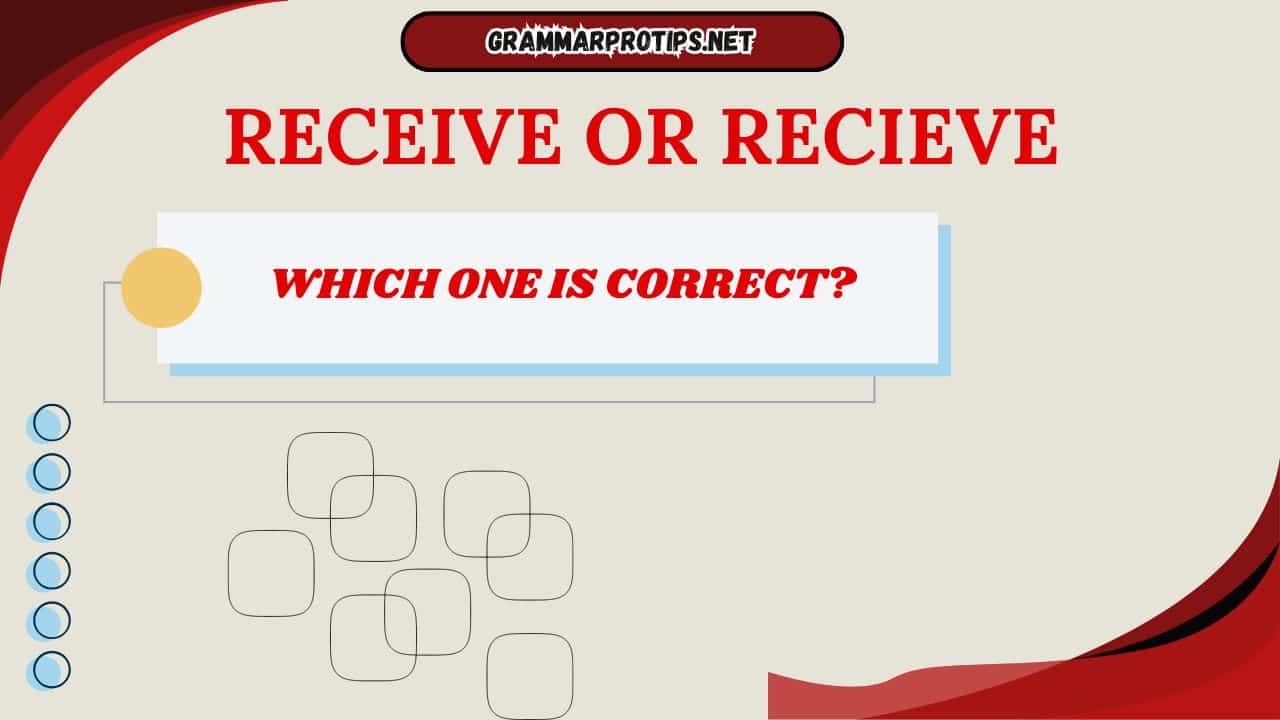Receive or Recieve: When it comes to spelling in English, a lot of people often find themselves wondering about the proper use of certain words.
One of the most common spelling dilemmas involves the words “receive” and “recieve.” While these words might seem similar, only receive is the correct spelling.
Understanding the rules behind this common confusion can help prevent spelling mistakes in both professional writing and email correspondence.
In this article, we will explore the spelling rule that governs this distinction, as well as offer some helpful examples to clarify the correct usage.
The Spelling Rule: i Before e, Except After C
The primary reason many people mistakenly spell receive as recieve is due to a common English spelling rule: “i before e, except after c.”
This rule helps guide the correct spelling of many English words, but it comes with its share of exceptions.
Understanding it can save you from embarrassing spelling errors, especially when writing in professional contexts.
What Does This Rule Mean?
The rule means that when “i” and “e” appear together in a word, the i should generally come before the e, except when they follow the letter c. For example:
- Receive – The i comes before the e, which follows the rule.
- Recieve – This is a misspelling because it violates the rule.
A Simple Breakdown of the Rule
| Correct Spelling | Explanation | Example Words |
|---|---|---|
| Receive | The “i” comes before “e” | Receive, Achieve, Belief |
| Recieve | This is a misspelling | Incorrect spelling |
| C + ie | “e” comes before “i” after “c” | Receive, Perceive |
Why Receive Is Correct
The word receive follows the rule of i before e because it does not come after the letter c, which makes it the correct spelling.
Understanding this rule helps you avoid the common mistake of typing recieve, which can be embarrassing in both informal writing and formal writing like emails or reports.
Example Scenario: Receiving an Email
Let’s consider an example where you, as a professional, are sending an email to confirm the receipt of a document. In this case, you would write:
Subject: Confirmation of Document Receipt
Dear Mr. Green,
I hope this message finds you well. I just wanted to receive confirmation from you regarding the document I sent last week. Could you kindly confirm if everything was in order?
Best regards,
Sarah Johnson
Project Manager
Notice that receive is used here in its correct form, ensuring that the email remains professional and clear.
The Incorrect Spelling: Recieve
Though it’s a frequent misspelling, recieve is incorrect. Many people accidentally spell receive this way, often due to the i before e rule being misunderstood or forgotten.
However, recieve does not conform to the rule and should be avoided in all writing.
Example Scenario: Misspelling in an Email
Imagine you’re drafting an email to a colleague but make the error of writing recieve instead of receive. Here’s what that might look like:
Subject: Inquiry Regarding Meeting Time
Dear Anna,
I wanted to check if you had a chance to recieve my email about the meeting tomorrow. Please let me know if you need any further details.
Best regards,
Mark Thompson
Marketing Assistant
In this case, the misspelling of recieve could give a careless impression to the recipient, especially in a professional setting.
To maintain high standards of writing professionalism, it’s essential to avoid such spelling errors.
How to Pronounce Receive and Recieve
Interestingly, receive and recieve are pronounced the same way, even though one is incorrect.
The “ei” combination in receive is pronounced as a long “ee” sound, just like words such as believe, achieve, and perceive.
- Receive – /rɪˈsiːv/
- Recieve – This would be pronounced the same, but it’s still a mistake.
So, even though the pronunciation might not help you spot the error, knowing the correct spelling rule can.
Common Misspellings and Errors in Professional Writing
In professional writing, spelling errors like recieve instead of receive can significantly harm your credibility.
In corporate emails, reports, or business proposals, these errors may seem small but could diminish the quality of your communication.
Avoiding common grammar mistakes like this one can improve your writing clarity and communication skills.
Example Scenario: Business Report Error
Imagine you’re working on a business report for a major project update. You might accidentally write:
“We expect to recieve the final approval by the end of the week.”
This could reflect poorly on you, especially if your manager or client spots the misspelling. Instead, using the correct spelling of receive ensures your report maintains a professional tone.
Receive vs. Recieve in Different Contexts
The difference between receive and recieve extends beyond formal writing.
It’s crucial to use the correct spelling in all types of communication, whether it’s emails, reports, or even casual messages.
Here are more examples to further illustrate the proper usage of receive:
Example Scenario: Customer Service Email
In a customer service context, you might write:
Subject: Order Confirmation
Dear Customer,
Thank you for placing an order with us. We have successfully received your payment and will begin processing your order. You will receive an email with tracking details once it ships.
Best regards,
Jessica Lee
Customer Service Representative
Notice the correct usage of received (the past tense form of receive). This simple step ensures clarity in email correspondence and improves customer trust.
Example Scenario: Job Application Email
When applying for a job, your spelling should be flawless. Here’s an example:
Subject: Application for Marketing Assistant Position
Dear Hiring Manager,
I am excited to apply for the Marketing Assistant position at your company. I would love to receive more information about the role and the next steps in the application process. I’ve attached my resume for your consideration.
Best regards,
Tom Harris
Marketing Graduate
Again, receive is used correctly, maintaining professionalism in the communication. This simple attention to detail is important when applying for positions in any field.
Importance of Proper Spelling in Email Correspondence
Email correspondence is one of the most common methods of communication, especially in the workplace.
Whether you’re writing to colleagues, clients, or prospective employers, proper spelling can make a significant difference in how your message is received.
A simple misspelling, such as recieve, could potentially cause your email to seem less professional or careless, impacting how others perceive you.
Example Scenario: Internal Company Memo
Consider this internal company memo:
Subject: Project Update
Dear Team,
I wanted to inform you all that we have officially received the necessary approvals for our upcoming project. The next steps will be shared during our meeting on Wednesday.
Best regards,
David Parks
Project Manager
The memo uses received correctly, ensuring that the message is clear and professional. Small errors in spelling, even in internal communication, can impact the tone of your message.
Conclusion: Receive Is the Correct Spelling
To wrap it up, receive is the correct spelling, and recieve is simply a common misspelling. By following the simple i before e rule, you can avoid this mistake and improve your writing.
Whether you’re sending a formal email, drafting a report, or engaging in professional writing, ensuring that you spell receive correctly is a small but powerful way to elevate the quality of your communication.
Here are some quick tips for avoiding spelling mistakes in your writing:
- Always apply the i before e rule unless the word follows a c.
- Double-check emails for any grammar mistakes before sending.
- Proofread your work to ensure writing clarity and avoid errors like recieve.
With this knowledge, you’ll be able to communicate more clearly, professionally, and confidently in any written context.
Read more knowledgeable blogs on Grammar Pro Tips

Sienna Mauldon is a passionate writer and grammar expert. On her blog, she shares easy-to-follow guides to help readers master grammar rules and improve their writing. With a love for language and teaching, Sienna makes grammar simple and fun for everyone, from beginners to experienced writers.








